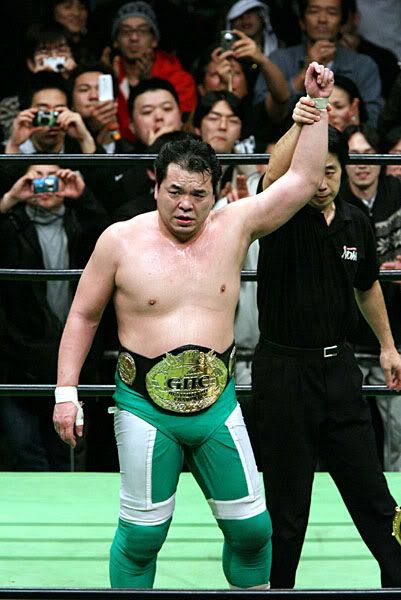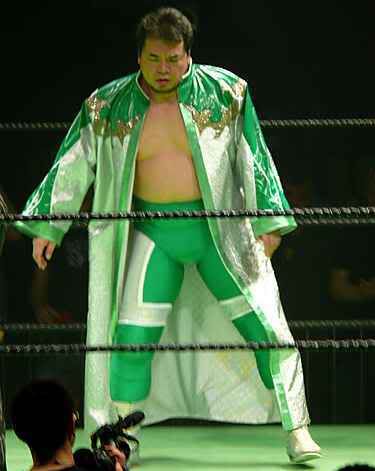wrestling / Hall of Fame
411 Wrestling Hall of Fame Class of 2012: Mitsuharu Misawa
 Image Credit: AJPW
Image Credit: AJPW
Mitsuharu Misawa was somebody who was born to wrestle, and he proved this point until the day of his untimely demise. He will always be one of the most important wrestlers in the history of Japan, and one of the best wrestlers of all time.
Mitsuharu Misawa because enamored in the world of professional wrestling at a very early age; so much so that he was about to drop out of school in order to get his start, but after an encounter with All Japan Pro Wrestling ace Jumbo Tsuruta (you’ll hear his name again), where Tsuruta convinced him to at least get his high school diploma, delayed that start by a few years.
That start was on August 21st, 1981, against Shiro Koshinaka , in the company that he loved so much in his younger days, AJPW. This start finally happened after, Misawa, a successful amateur wrestler, got wrestling training from AJPW owner Shohei “Giant” Baba, the legendary Dory Funk, Jr., and Dick “The Destroyer” Beyer.
Not much went on for Misawa after that until 1984 hit and AJPW bought the rights to the legendary Tiger Mask from New Japan Pro Wrestling and gave the gimmick to Misawa, so that he was now Tiger Mask (better known as Tiger Mask II), and while wrestling as Tiger Mask her innovated the both the Tiger Bomb, and the Tiger Driver ’85. In this moment in his career he feuded with such legends as Dynamite Kid and Kuniaki Kobayashi, before finally moving up to the heavyweight class, after 5 years in the light heavyweight division.
Once in the larger division he had a few unsuccessful feuds with the larger stars like Jumbo Tsuruta and Genichiro Tenryu, as well as having shots at both the AWA and NWA World titles, but those also ended in failure, and in 1989 he was put on the shelf from April to January of 1990 due to a knee injury.
After coming back, he had a time-limit with Bret Hart at the WWF/NJPW/AJPW in April, and was chosen as the person to become the new star or AJPW after one of their bigger stars in Genichiro Tenryu. So a few weeks after his Bret Hart mask, he asked his tag-team partner Toshiaki Kawada (not the last time you’ll hear about him) to rip off his Tiger Mask mask so he could wrestle as himself, the first time he did so in six years.
A few weeks after that, he defeated the legendary Jumbo Tsuruta, which instantly made him a much bigger name and a threat to the AJPW Triple Crown Heavyweight Championship, which he lost his first attempt on attaining it against Stan Hansen. After that he challenged Tsuruta to a rematch but lost, though he later avenged this loss when he and his partner at the time, Toshiaki Kawada, beat Tsuruta and Akira Taue in a tag match in AJPW’s Real World Tag League tournament.
But Misawa challenged Tsuruta another time, this time for the Triple Crown Heavyweight Championship, and failed yet again. But his spirits were not dampened, he went right back to competition, and he beat one of the top stars in the company, Terry Gordy, twice, and the second time was with Kawada yet again, and this time they won the AJPW World Tag Team titles.
Misawa finally got his revenge on Tsuruta, by making him submit in his first tag team title defense with Toshiaki Kawada. A year later, Misawa finally captured the title that had been eluding him for so long, he beat Stan Hansen for his first of five AJPW Triple Crown Heavyweight Championships. This reign lasted for two years, until “Dr.Death” Steve Williams unseated him as champion.
After that, it was a whirlwind for Mitsuharu Misawa and his rivals. Misawa was now fixed as one of the top wrestlers in all of Japan, with AJPW’s main event scene always having him either in the spotlight or the shadows. The 90s also saw him garner numerous awards from all over the world, one of the biggest being an inaugural member of the 1996 Wrestling Observer Newsletter Hall of Fame, and another feat is his astounding 22 five star matches! He also added some brutal elbows to the forefront of his offense as well as creating the elbow suicida (suicide dive with an elbow at the end) and the awesome Emerald Flowsion. Toshiaki Kawada was one of his main adversaries during this decade, with it only ending after Kawada had pinned Misawa twice, in two straight matches, to win the Triple Crown Championship. His opponent then became my favorite against him, his former tag partner, Kenta Kobashi, and the two tore it up every time they met.

The decade did not end all roses for Mitsuharu Misawa though, AJPW booker Giant Baba died in 1999 and Misawa inherited the president job because of that, but he only lasted a year, because he had disagreements with Baba’s widow, and was removed by the board of executives in 2000.
After that, Misawa left the company that he had called home for so many years, and started his own wrestling company, and it was called Pro Wrestling NOAH. Almost all of the wrestlers from All Japan came with him as well, 23 other wrestlers that resigned from the company when he did filled their roster quite well and the company did quite well for most of the time that he was in charge. In 2005, he, along with his tag team partner Yoshinari Ogawa, won the GHC Tag Team Championships, and even after losing it, Misawa mainly competed in tag matches for the rest of his career.
But that is not to say that his singles career was quite over, on December 10th, 2006, Misawa defeated then-champion, Naomichi Marufuji win his 3rd GHC Heavyweight Championship. He defended it numerous times, including once at a Ring of Honor show in New York against KENTA. But all good things come to an end, as Takeshi Morishima defeated Misawa in March of 2008 to end Misawa’s final reign.
On June 13th, 2009, while tagging with Go Shiozaki against Akitoshi Saito and Bison Smith for the GHC Tag Team Championships. His journey would come to an end. Towards the early part of the match, Misawa took a standard back drop, and became unconscious, then started getting cold. His official cause of death was never released due to his family evoking a Japanese law that says that the cause of death does not have to be revealed.

But what made his death so odd was that fact that a standard, everyday bump is what killed him. The police report suspected that it was a spinal cord fracture that led to a heart attack. The spinal cord problems should not be all too big of a surprise, because when you look at his matches. The guy bumped hard, and did so with no interest as to his well being. Misawa was one of the most popular users of the “King’s Road” style of wrestling that was a staple of All Japan for a while, the style was largely based around the story between the two combatants, with the matches getting longer and more brutal because of the fact that their matches were not as hyper realistic as the Strong Style of wrestling used by New Japan, and to compensate for that fact, the All Japan wrestlers would compensate for the fact that their matches were not as logical, but instead more based around emotion. They compensated for this with a lot of stiff strikes as well as lots of drops on the head. and this bumps have been shown to kill. Just looking at the number of head bumps he took was astonishing, he took 3 of Kenta Kobashi’s Burning Hammers, and due to the danger involved with the move, Kobashi has only delivered it 7 times. He also took 2 of Toshiaki Kawada’s Kawada Bombs, which there have only been 3 of, and all it was a literal head drop.
Why Misawa Was Selected…
Mitsuharu Misawa is one of the most important wrestlers in history, this is without a doubt! He was the second incarnation of the legendary Tiger Mask character. He was one of the most important main event stars in the 1990s, only behind “Stone Cold” Steve Austin, and maybe Hulk Hogan when it came to how crucial he was to the company. His matches were stellar, and he was perhaps one of the best wrestlers if his era. His name is also tied into the legacies of other legends in Japan such as Jumbo Tsuruta, Kenta Kobashi, Toshiaki Kawada, and Akira Taue. He also started the third biggest company in Japan with Pro Wrestling NOAH, which is the third biggest company in Japan. His name carries so much weight that when he left All Japan, almost all but 4 wrestlers went with him. He leaves behind a legacy of blood, sweat, and excellence and his name is more than worthy of being spoken of when the name of the greatest wrestlers of all time are being discussed.
More Trending Stories
- Note On Possible WWE Storyline & Faction For The Creed Brothers (POSSIBLE SPOILERS)
- Tony Khan Weighs In On Warning From Oklahoma Athletic Commission Over Nyla Rose Match
- Backstage Update on WWE’s Plans for WrestleMania 41, Possible Move to March or May
- Jim Ross Recalls Dustin Rhodes Being Fired From WCW For Not Following No-Blood Policy







